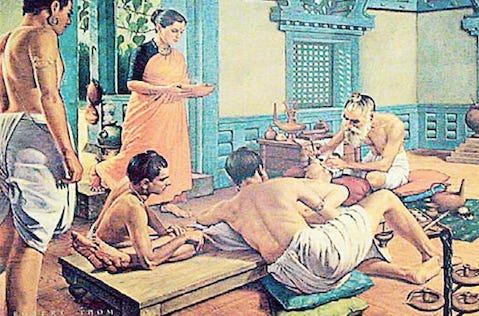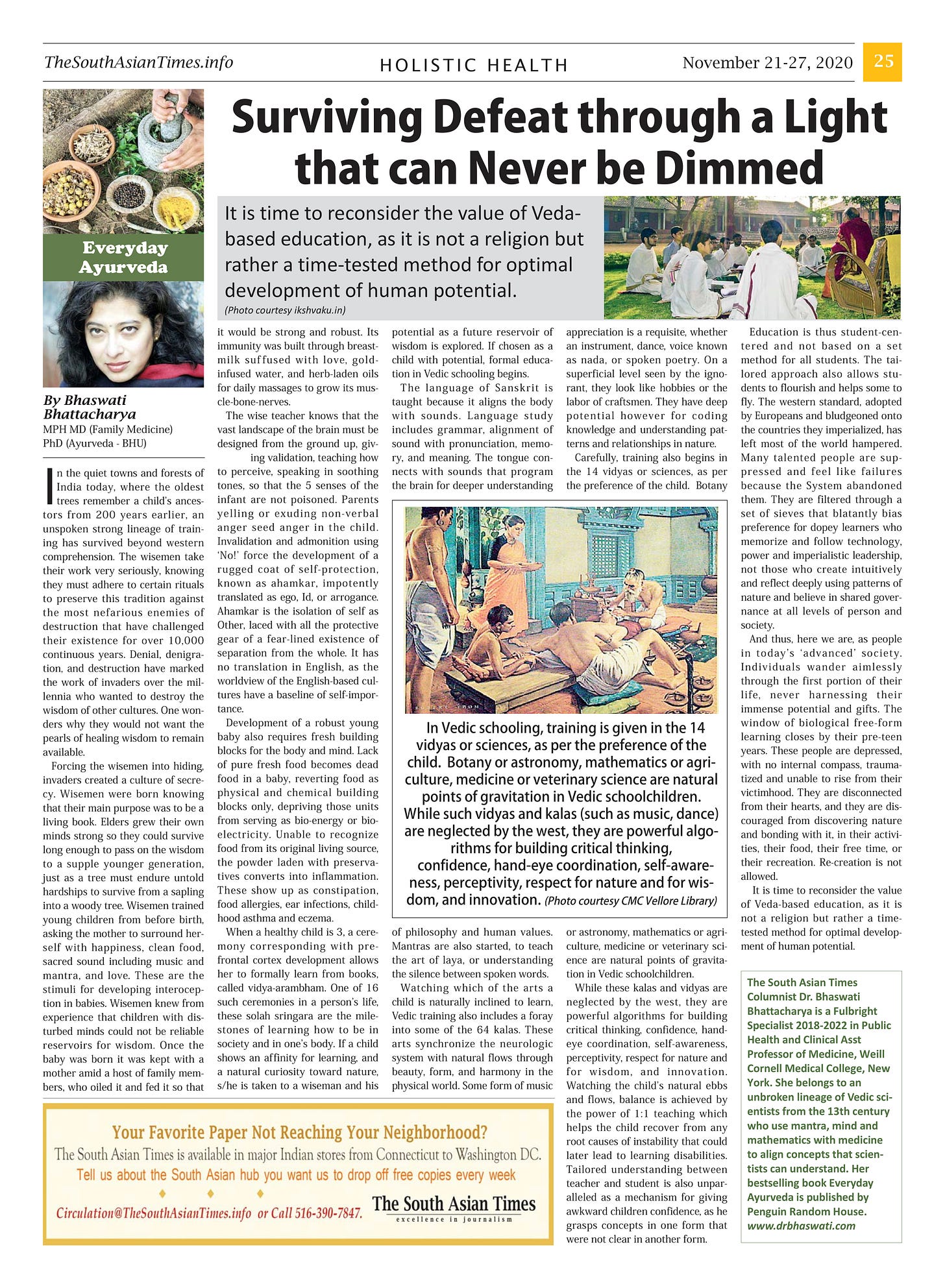Surviving Defeat, Lighting the Flame of Resilience
The wise teacher knows that the vast landscape of the brain must be designed from the ground up, giving both challenge and validation, teaching how to perceive speaking using soothing tones that open the mind, so that the 5 senses of the young mind are not poisoned with defeat.
Surviving Defeat through a Light that can Never be Dimmed
In the quiet towns and forests of India today, where the oldest trees remember a child’s ancestors from 200 years earlier, an unspoken strong lineage of training has survived beyond western comprehension. The wisemen take their work very seriously, knowing they must adhere to certain rituals in order to preserve this tradition against the most nefarious enemies of destruction that have challenged their existence for over 10,000 continuous years. Denial, denigration, and destruction have marked the work of invaders over the millenia who wanted to destroy the wisdom of other cultures. One has to wonder why they would not want the pearls of healing wisdom to remain available.
Forcing the wisemen into hiding, invaders created a culture of secrecy. Wisemen were born knowing that their main purpose was to be a living book. Elders grew their own minds strong so they could survive long enough to pass on the wisdom to a supple younger generation, just as a tree must endure untold hardships in order to survive from a sapling into a woody tree. Wisemen trained young children from before birth, asking the mother to surround herself with happiness, clean food, sacred sound including music and mantra, and love. These are the stimuli for developing interoception in babies. Wisemen knew from experience that children with disturbed minds could not be reliable reservoirs for wisdom. Once the baby was born it was kept with a mother amid a host of family members, who oiled it and fed it so that it would be strong and robust. Its immunity was build through breastmilk suffused with love, gold-infused water, and herb-laden oils for daily massages to grow its muscle-bone-nerves.
The wise teacher knows that the vast landscape of the brain must be designed from the ground up, giving validation, teaching how to perceive, speaking in soothing tones, so that the 5 senses of the infant are not poisoned. Parents yelling or exuding non-verbal anger seed anger in the child. Invalidation and admonition using ‘No!’ force the development of a rugged coat of self-protection, known as ahamkar, impotently translated as ego, Id, or arrogance. Ahamkar is the isolation of self as Other, laced with all the protective gear of a fear-lined existence of separation from the whole. It has no translation in English, as the worldview of the English-based cultures have a baseline of self-importance.
Development of a robust young baby also requires fresh building blocks for the body and mind. Lack of pure fresh food become dead food in a baby, reverting food as physical and chemical building blocks only, depriving those units from serving as bio-energy or bioelectricity. Unable to recognize food from its original living source, the powder laden with preservatives converts into inflammation. These show up as constipation, food allergies, ear infections, childhood asthma and eczema.
When a healthy child is 3, a ceremony corresponding with pre-frontal cortex development allows her to formally learn from books, called vidya-arambham. One of 16 such ceremonies in a person’s life, these solah sringara are the milestones of learning how to be in society and in one’s body. If a child shows an affinity for learning, and a natural curiosity toward nature, s/he is taken to a wiseman and his potential as a future reservoir of wisdom is explored. If chosen as a child with potential, formal education in vedic schooling begins.
The language of Sanskrt is taught because it aligns the body with sounds. Language study includes grammar, alignment of sound with pronunciation, memory, and meaning. The tongue connects with sounds that program the brain for deeper understanding of philosophy and human values. Mantras are also started, to teach the art of laya, or understanding the silence between spoken word.
Watching which of the arts a child is naturally inclined to learn, vedic training also includes a foray into some of the 64 kalaas. These arts synchronize the neurologic system with natural flows through beauty, form, and harmony in the physical world. Some form of music appreciation is a requisite, whether an instrument, dance, voice known as nada, or spoken poetry. On a superficial level seen by the ignorant, they look like hobbies or the labor of craftsmen. They have deep potential however for coding knowledge and understanding patterns and relationships in nature.
Carefully, training also begins in the 14 vidyAs or sciences, as per the preference of the child. Botany or astronomy, mathematics or agriculture, medicine or veterinary science are natural points of gravitation in vedic schoolchildren.
While these kalaas and vidyAs are neglected by the west, they are powerful algorithms for building critical thinking, confidence, hand-eye coordination, self-awareness, perceptivity, respect for nature and for wisdom, and innovation. Watching the child’s natural ebbs and flows, balance is achieved by the power of 1:1 teaching which helps the child recover from any root causes of instability that could later lead to learning disabilities. Tailored understanding between teacher and student is also unparalleled as a mechanism for giving awkward children confidence, as he grasps concepts in one form that were not clear in another form.
Education is thus student-centered and not based on a set method for all students. The tailored approach also allows students to fluorish and helps some to fly. The western standard, adopted by Europeans and bludgeoned onto the countries they imperialized, has left most of the world hampered. Many talented people are suppressed and feel like failures because the System abandoned them. They are filtered through a set of sieves that blatantly bias preference for dopey learners who memorize and follow technology, power and imperialistic leadership, not those who create intuitively and reflect deeply using patterns of nature and believe in shared governance at all levels of person and society.
And thus, here we are, as people in today’s ‘advanced’ society. Individuals wander aimlessly through the first portion of their life, never harnessing their immense potential and gifts. The window of biological free-form learning closes by their pre-teen years. These people are depressed, with no internal compass, traumatized and unable to rise from their victimhood. They are disconnected from their hearts, and they are discouraged from discovering nature and bonding with it, in their activities, their food, their free time, or their recreation. Re-creation is not allowed.
It is time to reconsider the value of veda-based education, as it is not a religion but rather a time-tested method for optimal development of human potential.
week35. TheSouthAsianTimes
Obtain the .pdf version of this column by clicking on the image.
Dr. Bhaswati Bhattacharya is a Fulbright Specialist 2018‐2023 in Public Health. She serves as Clinical Asst Professor of Family Medicine in the Department of Medicine at Weill Cornell Medical College in New York, NY. Her bestselling book Everyday Ayurveda is published by Penguin Random House. To order an autographed copy, write to bhaswati@post.harvard.edu.
www.drbhaswati.com






